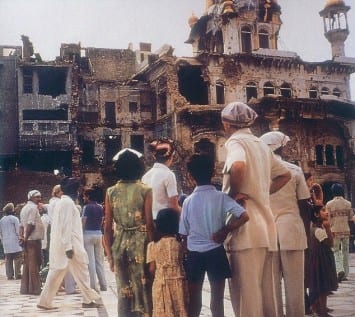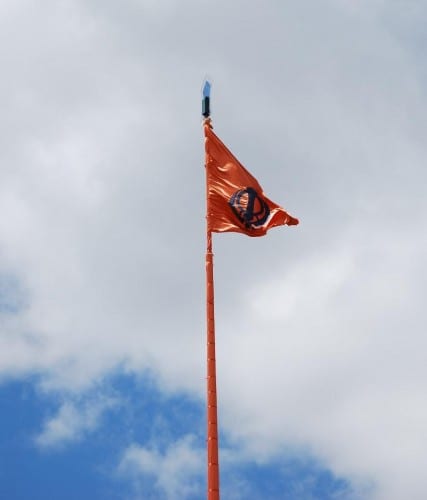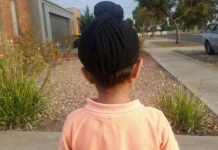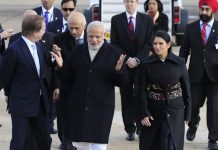There were two stages to the Allied assault. Stage one on 6th June 1944, called Operation Neptune. It involved the largest sea born invasion in human history which involved 10,000 boats and ships landing 150,000 troops in one day. Stage two, codenamed Operation Overlord represented the allied penetration into Western Europe leading the rapid liberation of France and eventually [the] defeat of Hitler and the 3rd Reich.
Similarly, in another time and place, 30 years ago, on 6th June 1984 we witnessed the enactment of two military operations, and like D-Day, the operation involved some 150,000 troops but with one significant difference; on this occasion we saw the India Army invading a holy place and killing 1000’s of its own citizens.



Operation Blue Star in 1984
Stage one, code named Operation Blue Star, was led by Gen. A.S. Vaydia and executed by General K. S. Brar after a refusal from Lt. Gen. S. K. Sinha, a Hindu military man and the then Vice-Chief of Indian Army, on the grounds that his job was to defend Indian citizens. It involved a full scale military assault on the Darbar Sahib (Golden Temple) in Amritsar, India. The pretext to the attack was that some armed militants were [hiding] out in the temple. Over a period of 4 days large sections of the Darbar Sahib complex, the holiest shrine for the 30 million world wide Sikh community, were destroyed. Though we have never discovered the actual numbers of casualties, Government [officials estimate that 1,000 pilgrims lost their lives,] but the SGPC confirmed that 10,000 pairs of shoes remained unclaimed by pilgrims.
Stage 2, Operation Blue Star was quickly followed by Operation Woodrose, which resulted in 150,000 India Army troops attacking another 50 historical Gurdwaras and [as] many [as] 1000 [more] in villages as they fanned across the Punjab countryside. Their orders were to roundup Amridhari (Baptised) Sikh boys and men of fighting age and take them into custody. Over a period of days and weeks 1000 Sikhs, accused of being terrorists and separatists, and therefore a threat to the integrity and sovereignty of India, were imprisoned, tortured and killed. Also, accused of providing shelter and food for the so called “terrorists,” many simple villagers, both men and women, were not spared.
Tragically, the events from June to Oct 1984 were but a precursor to a full scale program unleashed on Sikhs across India. On 31 October 1984 Indira Gandhi, the then Prime minister of India, was assassinated by two of her Sikh bodyguards in what was viewed as an act of vengeance. Subsequently, over a period of 4 days under the gaze of world leaders who had arrived to attend Mrs. Gandhi’s funeral the Sikh suburbs of Delhi went up in flames and an estimated 10,000 innocent Sikhs were massacred in Delhi alone.
Though portrayed as a communal riot resulting from a spontaneous outburst of anger by Hindus against Sikh, all the evidence points towards a State led pogrom against innocent Sikhs. Specifically, subsequent enquiries and testimonials point towards The Congress Party high [in] command and in particular Indira Gandhi’s son Rajeev who when asked on national media about the pogroms being unleashed against innocent Sikhs, simply replied “when a big tree falls the ground does shake.”
But the horror does not end in 1984. Throughout the next 10 years, under the aegis of the Terrorist and Disruptive Activities (Prevention) Act (TADA), which was in force in Punjab between 1985 and 1995, an estimated 100,000 innocent people were victims of state sponsored terrorism under the guise of fake encounters [and] extra judicial killings by the Punjab Police force.
30 years later, the psychological, and in some cases, physical, scars still traumatize the Sikh community. In many parts of Punjab Sikhs, young and old, male and female, have succumbed to shocking levels of alcohol and drug addiction.
On Sunday 8th June [thousands] of people, Sikh and non-Sikh marched through the streets of London demanding Truth, Justice and Freedom. Similar events have been held throughout the world though interestingly, in Indian and specifically Punjab, protests have been muted.
Some people suggest that the events of 1984 need to be consigned to the dustbin of history, that unless they do so Sikhs will never be able to move forward. Others argue that, until justice is [served], even suggesting we forget 1984 is an act of betrayal against many of [the] people who sacrificed their lives and the remaining families [of victims] who continue to suffer.
Whatever ones position, there can be no doubting that, despite the passage of time, for large sections of the Sikh diaspora, the memory of 1984 is still fresh and [the] desire for justice and freedom is stronger than ever. That said, mixing in with the crowds, observing the banners and listening to the speeches, one gets a real impression that the desire to move on to some closure was there. Though the slogans for Khalistan were still prevalent, the anger and resentment displayed on previous occasions was largely absent and the true spirit of Sikhi, was clearly evident, both in the way the whole event was organized and in general unity (ekta) that was being displayed by everybody present.
As Kulwant Singh Dhesi, an influential Sikh intellectual passionately argued in his speech,”Now is the time to let go of our enmities and embrace each other despite our differences. Irrespective of the past and any differences we might have in our political views about Khalistan, we must not let these get in the way of working together.”
As well as a call for Sikhs to unite, there was another important feature, namely unity amongst the Sikh media. This was powerfully displayed in the nesting of the logo’s of three TV channels on the microphones. Various speakers acknowledged the role of the media and that without the absolute unanimity displayed by all three TV channels and other Sikh media outlets, the event would not have succeeded.


 Put simply, the Sikh media has transformed and reenergized the Sikh freedom and justice movement and the march on 8th June demonstrated the power and influence it has over Sikh affairs. And so, in taking on its responsibility for continuing to put the Sikh case, it is also incumbent on the media to not only maintain this unity that the 8th June commemoration generated but to lead by example.
Put simply, the Sikh media has transformed and reenergized the Sikh freedom and justice movement and the march on 8th June demonstrated the power and influence it has over Sikh affairs. And so, in taking on its responsibility for continuing to put the Sikh case, it is also incumbent on the media to not only maintain this unity that the 8th June commemoration generated but to lead by example.
Given the general conviviality that has broken out amongst various Sikh organizations and the media, there is an opening to cement unity in developing a protocol for all the Sikh media, be it the TV channels (both terrestrial and web based), Radio stations and the two main print media. One of the most common calls on all media outlets is Panthik unity, but there is also a responsibility to lead by example.
One practical way forward could be to establish and equivalent of “OFCOM” for the Sikh media possibly facilitated by the Sikh Council UK. As well as developing some general protocols such a body could also provide a space for arbitration, therefore avoiding expensive and publically damaging complaints. Indeed, such a body could become a model for all Sikh institutions and especially gurdwara’s to resolve internal disputes.
Given our numbers, Sikhs are destined to minority status in most contexts and therefore our future survival and prosperity is critically dependent on our capacity to unite. There are glorious historical examples of this happening, such as the periods of Bandha Singh Bahadurand Maharaj Ranjit Singh. On both occasions, despite their relatively low numbers, unity and an absolute commitment to humanitarian principles, enabled them to become popular rulers. If this happened in the past, then there should be no reason why it can’t happen in the future. The question is whether the leaders of the Panth, be they jathebandhis, intellectuals, journalists or activists are capable of rising to the challenge.
When we reflect on the courage and sacrifices of the 200,000 Sikh soldiers who served in British Army, we feel a sense of pride and honour. The attack on Darbar Sahib in 1984 robbed us of our dignity and we have not really fully recovered from that event and awful decade of state sponsored violence. Yes, we were/are victims of genocide but victimhood will not enable us to move forward. We may never get justice but we must reclaim our sovereignty, self confidence and realization that the Khalsa is and never has been a victim. 30 years after 1984 we need turn a new leaf and begin to narrate a new future, of a progressive, globaly successful unified people whose success is inspired by the wonderful teachings of our ultimate leader, Sri Guru Granth Sahib Ji. And in the end, is only through the Guru that we will achieve both unity and chardhi kala.




“Avar Updhesai Aap Naa Karai”
Brilliant point, if the media display mutual respect, share resources and furthermore treat ‘seva as seva’ (which they claim to do with the sangat’s maya) then there will be no conflict, the panthic ‘ofcom’ and further successes will come closer to fruition. Sometimes we give off the perception that we are not ready for self-governance, that is true especially about the media outlets when they argue and act foolishly and that too, publicly – together with the right protocols and guided oversight the media performance can be enhanced greatly.